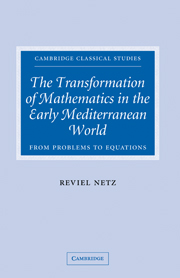Conclusion
Published online by Cambridge University Press: 05 May 2010
Summary
The outline of the argument of the book has now been repeated several times. Hellenistic Greek mathematical practice focused on the features of the individual proof, trying to isolate it and endow it with a special aura. Thus the characteristic object of Hellenistic Greek mathematics is the particular geometrical configuration. Medieval mathematical practice focused on the features of systems of results, trying to bring them into some kind of order and completion. Thus the characteristic object of medieval mathematics is the second-order expression. In a particular geometrical configuration, the mathematician foregrounds the local, qualitative features of spatial figures. In a second-order expression, the mathematician foregrounds the global, quantitative features of mathematical relations. Thus, Hellenistic Greek mathematics – the mathematics of the aura – gave rise to the problem; medieval mathematics – the mathematics of deuteronomy – gave rise to the equation.
The comparison between the two kinds of mathematics is at its starkest when we compare Hellenistic Greek mathematics directly with advanced Arabic mathematics. This comparison is useful, then, to get a sense of the nature of the transformation. But, to look for the historical account for this transformation, we have concentrated in this book on a more subtle comparison. In this book, I have given much attention to the transitional stage of Late Antiquity, already different from Classical Hellenistic mathematics, though in ways that are less obvious. In the work of Eutocius, we saw suggestions of the direction ahead.
- Type
- Chapter
- Information
- The Transformation of Mathematics in the Early Mediterranean WorldFrom Problems to Equations, pp. 187 - 192Publisher: Cambridge University PressPrint publication year: 2004

